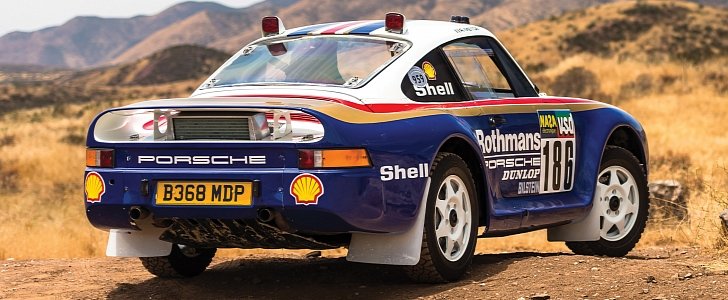Back when the 911 was Porsche’s main pillar in the range and the 924 and 944 were still around, the automaker decided to put all of its know-how into one project. The iconic 959 was born from this ambition, and the rest - as they say - is history.
Before the production version came to be in 1986, Porsche modified the 911 to Group B specification for rallying, thus giving birth to the 953. One of those purpose-built cars went on to win the Paris-Dakar Rally in 1984, but the following year, the 953 evolved into the 959. Chassis 010015 here is the first of three 959s made in 1985.
Even though it retired from the rally with an oil line failure along with the other two 959s, this particular model is special for a number of reasons. The engine, for example, is the 3.2-liter naturally aspirated boxer from the 911 instead of the 2.9-liter twin-turbo engine we know from the road-going model. Then there’s the pedigree, after which it should be mentioned this fellow is the first Paris-Dakar 959 to be offered for public auction.
“It is fantastic to be able to offer one of the very few 959 Paris-Dakar rally cars at auction, especially at our Porsche 70th Anniversary sale,” said Alexander Weaver of RM Sotheby’s. Estimate? Expect something in the ballpark of $3 to $3.4 million.
Along with this mechanical marvel that paved the way for the arch-nemesis of the Ferrari F40, the auction also includes a 959 prototype from the same year. Identified under the codename F7, this fellow carries an estimate of $1.3 to $1.6 million. Finished in Ruby Red paintwork over the Triple Silver interior, F7 is believed to be one of three or four surviving prototypes. F7 could also be the only prototype that’s still in running order.
Created for hot-weather and electrical system testing, the car was put through its paces in places as far apart as Australia and San Francisco. The hollow magnesium wheels finished in pearlescent white are also a rarity. Last, but certainly not least, the design of the rear wing and headlights is noticeably different from the production model.
Even though it retired from the rally with an oil line failure along with the other two 959s, this particular model is special for a number of reasons. The engine, for example, is the 3.2-liter naturally aspirated boxer from the 911 instead of the 2.9-liter twin-turbo engine we know from the road-going model. Then there’s the pedigree, after which it should be mentioned this fellow is the first Paris-Dakar 959 to be offered for public auction.
“It is fantastic to be able to offer one of the very few 959 Paris-Dakar rally cars at auction, especially at our Porsche 70th Anniversary sale,” said Alexander Weaver of RM Sotheby’s. Estimate? Expect something in the ballpark of $3 to $3.4 million.
Along with this mechanical marvel that paved the way for the arch-nemesis of the Ferrari F40, the auction also includes a 959 prototype from the same year. Identified under the codename F7, this fellow carries an estimate of $1.3 to $1.6 million. Finished in Ruby Red paintwork over the Triple Silver interior, F7 is believed to be one of three or four surviving prototypes. F7 could also be the only prototype that’s still in running order.
Created for hot-weather and electrical system testing, the car was put through its paces in places as far apart as Australia and San Francisco. The hollow magnesium wheels finished in pearlescent white are also a rarity. Last, but certainly not least, the design of the rear wing and headlights is noticeably different from the production model.












